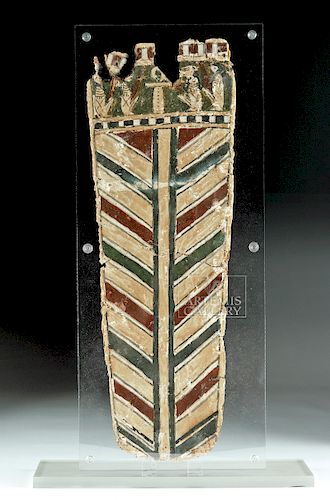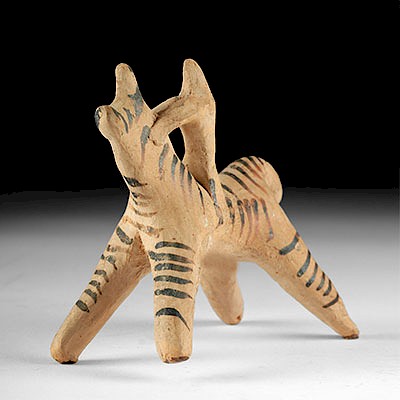Egyptian Cartonnage Leg Panel w/ Sons of Horus & Ankh
Lot 9
About Seller
Artemis Gallery
686 S Taylor Ave, Ste 106
Louisville, CO 80027
United States
Selling antiquities, ancient and ethnographic art online since 1993, Artemis Gallery specializes in Classical Antiquities (Egyptian, Greek, Roman, Near Eastern), Asian, Pre-Columbian, African / Tribal / Oceanographic art. Our extensive inventory includes pottery, stone, metal, wood, glass and textil...Read more
Estimate:
$1,200 - $1,800
Absentee vs Live bid
Two ways to bid:
- Leave a max absentee bid and the platform will bid on your behalf up to your maximum bid during the live auction.
- Bid live during the auction and your bids will be submitted real-time to the auctioneer.
Bid Increments
| Price | Bid Increment |
|---|---|
| $0 | $25 |
| $300 | $50 |
| $1,000 | $100 |
| $2,000 | $250 |
| $5,000 | $500 |
| $10,000 | $1,000 |
| $20,000 | $2,500 |
| $50,000 | $5,000 |
| $100,000 | $10,000 |
| $200,000 | $20,000 |
About Auction
By Artemis Gallery
Oct 25, 2018
Set Reminder
2018-10-25 11:00:00
2018-10-25 11:00:00
America/New_York
Bidsquare
Bidsquare : Antiquities from Egypt, Greece, Italy, Asia
https://www.bidsquare.com/auctions/artemis-gallery/antiquities-from-egypt-greece-italy-asia-3538
Featuring Egyptian, Greek, Roman, Etruscan, Near Eastern, plus Asian art from Central and Far East. If you love the classics, this is the sale for you. Artemis Gallery info@artemisgallery.com
Featuring Egyptian, Greek, Roman, Etruscan, Near Eastern, plus Asian art from Central and Far East. If you love the classics, this is the sale for you. Artemis Gallery info@artemisgallery.com
- Lot Description
Egypt, Late Dynastic to Ptolemaic Period, ca. 664 to 30 BCE. A beautiful gessoed cartonnage panel meant to be set atop the legs of a mummy prior to burial. Rectangular in form, this panel displays a central black-and-tan vertical stripe flanked by two lateral registers of alternating red, blue, tan, and white hues. The upper register depicts the four sons of Horus - Duamutef, Imsety, Hapy, and Qebehsenuef - seated on either side of a central ankh, an important and ancient hieroglyph symbolizing life. The upper horizontal and lower vertical registers are separated by a segmented black-and-white panel. Custom lucite display stand included. Size (panel): 6.25" W x 18" H (15.9 cm x 45.7 cm); size (lucite stand): 12" W x 19.75" H (30.5 cm x 50.2 cm).
Ancient Egyptians believed it was of the utmost importance to preserve a body of the deceased, because the soul needed a place to reside after the death. Preservation of the body was done via mummification - a process involving the removal of internal organs that were placed in canopic jars, wrapping body in linen, and then embalming.
Artisans were able to employ the use of different materials when crafting sarcophagi or any elements to be placed atop the deceased. Earlier elements like death masks or body coverings were carved from wood, while later ones like this example were made of cartonnage, a material made from papyrus or linen and soaked in plaster which was then applied to a wooden mold.
Provenance: private Boulder, Colorado, USA collection; ex-private Hallen collection, Oregon, USA, acquired at auction at Ancient Resources, Montrose, California, USA in February, 2011; ex-old private San Francisco, California, USA collection
All items legal to buy/sell under U.S. Statute covering cultural patrimony Code 2600, CHAPTER 14, and are guaranteed to be as described or your money back.
A Certificate of Authenticity will accompany all winning bids.
We ship worldwide and handle all shipping in-house for your convenience.
#139164Panel repaired from multiple large pieces with some small losses and light adhesive residue along break lines. Surface wear and abrasions commensurate with age, small losses to upper register, peripheries, and some internal areas, with fading to some areas of pigmentation, and desiccation as shown. Nice earthen deposits and pigmentation throughout.Condition
- Shipping Info
-
All shipping is handled in-house for your convenience. Your invoice from Artemis Gallery will include shipping calculation instructions. If in doubt, please inquire BEFORE bidding for estimated shipping costs for individual items.
-
- Buyer's Premium



 EUR
EUR CAD
CAD AUD
AUD GBP
GBP MXN
MXN HKD
HKD CNY
CNY MYR
MYR SEK
SEK SGD
SGD CHF
CHF THB
THB















